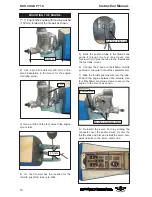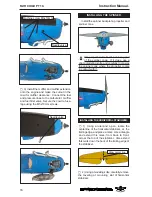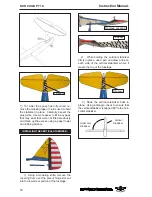
FAIR CHILD PT 19.
Instruction Manual.
28
We wish you many safe and enjoyable
flights with your PT 19.
7) Check the receiver antenna. It should
be fully extended and not coiled up inside the
fuselage.
3) Double check the balance of the air-
plane. Do this with the fuel tank empty.
4) Check the control surfaces. All should
move in the correct direction and not bind in
any way.
5) If your radio transmitter is equipped
with dual rate switches double check that they
are on the low rate setting for your first few
flights.
2) Check every bolt and every glue joint
in the
PT 19
to ensure that
everything is tight and well bonded.
6) Check to ensure the control surfaces
are moving the proper amount for both low
and high rate settings.
1) Completely charge your transmitter
and receiver batteries before your first day of
flying.
D) Check the throttle. Moving the
throttle stick forward should open the carbu-
retor barrel. If it does not, flip the servo re-
versing switch on your transmitter to change
the direction.
E) From behind the airplane, look at
the aileron on the right wing half. Move the
aileron stick to the right. The right aileron
should move up and the other aileron should
move down. If it does not, flip the servo re-
versing switch on your transmitter to change
the direction.
C) Check the rudder. Looking from
behind the airplane, move the rudder stick to
the right. The rudder should move to the right.
If it does not, flip the servo reversing switch on
your transmitter to change the direction.
A) Plug in your radio system per the
manufacturer's instructions and turn every-
thing on.
B) Check the elevator first. Pull back
on the elevator stick. The elevator halves
should move up. If it they do not, flip the servo
reversing switch on your transmitter to change
the direction.
8) Properly balance the propeller. An out
of balance propeller will cause excessive vi-
bration which could lead to engine and/or air-
frame failure.
PREFLIGHT CHECK.
Check the operation and direction of the
elevator, rudder, ailerons and throttle.
FLIGHT PREPARATION.

































